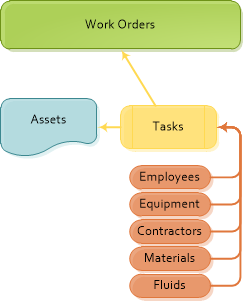
Cost fields appear on each Work Order record, Work Order Asset record, Work Task record, and Work Resource record. Tracking these costs enables you to calculate how much money was spent on each aspect of the Work Order.
Types of Cost Data and How They Relate
Costs on a Work Order typically originate on Resource records (represented in orange in the diagram below) and then roll up to the associated Task record (yellow).
Task costs are then used in two other calculations: 1) They are rolled up to the Work Order (green) to determine the Total Cost of the Work Order. 2) Task costs are also divided over the Work Order's Assets (blue) to determine what it cost to work on each asset.
When creating a Work Order, users can choose to either:

Work Order Costs
Work Order Costs, which are tracked through the Cost fields on the Work Order form, represent the cost of completing the entire Work Order. Users can enter Work Order Costs manually or allow the system to calculate them by adding the cost of each Task listed on the Work Order.
More information about Work Order Cost fields
Work Task Costs
Work Task Costs, which are tracked through the Cost fields found on records in the Work Order's Task grid, indicate the cost of performing each individual Task. Work Task Costs are also used to determine how much the work cost per Asset.
Users can enter Work Task Costs manually or allow the system to calculate them by adding the cost of each Resource (Employees, Equipment, Contractors, Materials, and Fluids) associated with the Task.
More information about Task/Asset relationships
More information about Task Cost fields
Work Resource Costs
Work Resource Costs, which are detailed using the Cost fields found on the records in each Task's Resource grids, represent the cost of each individual Resource (Employees, Equipment, Contractors, Materials, and Fluids) used to complete the Work Order. Resource Costs are based on the amount the resource that was used—for example, the number of hours an employee worked or the amount of pipe required to fix a sewer leak.
Other factors may also affect Resource Cost calculations:
Users can enter Work Resource Costs manually or allow the system to calculate them by multiplying Unit values by default Cost data obtained from related Work Flow Setup records or Parts Inventory records.
Note: Users can override the default cost of an item by entering a value in the Override Unit Cost field on the resource record. Note, however, that the costs of Materials or Fluids that are linked to Lucity's Parts Inventory cannot be overridden.
More information about Employee Cost fields
More information about Equipment Cost fields
More information about Contractor Cost fields
More information about Material Cost fields
More information about Fluid Cost fields
Work Asset Costs
Work Asset Costs show the cost of working on individual Work Order assets. The system calculates Work Asset Costs using data from the Tasks linked to each Asset.
More information about Asset Cost fields
More information about Task/Asset relationships
Cost Calculations
Lucity calculates costs automatically; however, these calculations can tie up system resources, particularly when a Work Order has many Tasks or Assets. Agencies that create large Work Orders can defer cost calculation processing using the "Defer Task and Asset Calculations to Nightly Process" Work Option. This feature allows users to save Work Order records quickly; however, using this feature means that calculations will not always be up to date.